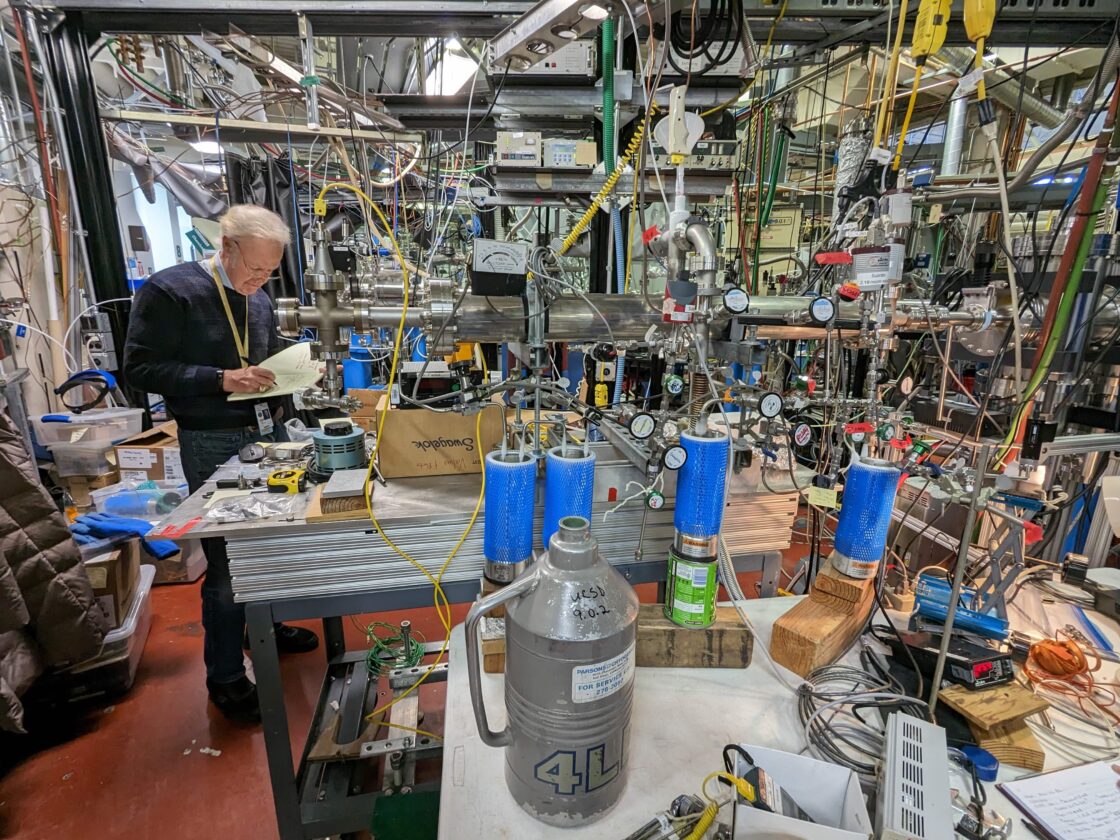When Earth formed more than 4.5 billion years ago, the atmosphere was dominated by hydrogen—not a particularly inviting environment for most organic life. Today, our atmosphere is primarily nitrogen, with just the right amount of oxygen to support life but not ignite spontaneous fires. The evolution of our atmosphere and how it compares to the atmosphere on other planets has long intrigued scientists.
In this context, a multi-institutional team of researchers focused on nitrogen isotopes. Nitrogen can occur as two stable isotopes—the more common and lighter 14N (99.3%) and the less available and heavier 15N (0.7%). Isotopic mass affects the rate at which the isotope is assimilated into compounds.
“Isotopes are fingerprints that are used to reconstruct past conditions,” said Mark Thiemens, distinguished professor of chemistry and biochemistry at the University of California, San Diego. “To interpret these measurements, you have to understand the different fundamental processes that change the isotopes in the sample and use that information to dissect what the environment was that created the signature.”
The team recreated how the Sun’s ultraviolet radiation breaks a molecule apart through a series of meticulous experiments conducted at the Advanced Light Source (ALS) at Lawrence Berkeley National Laboratory (Berkeley Lab). The data was integral in establishing a new model that can be used to understand the fate of a variety of elemental isotopes that could explain atmospheric evolution on planets across the solar system.
Recreating the Sun at the ALS
During photodissociation, ultraviolet solar radiation breaks molecules into smaller fragments, or reactive atoms, of different electronic states. To experimentally recreate this phenomenon, the team used vacuum ultraviolet (VUV) photons at the Chemical Dynamics Beamline (9.0.2) at the ALS, across the wavelengths emitted by stars. The radiation source was connected to an experimental reaction chamber maintained at low temperature that offered a more realistic recreation of astrophysical environments and better experimental conditions.
Thiemens exposed samples of equal parts highly pure nitrogen and hydrogen gas to the different bands of energy to monitor how fragmented nitrogen reacted with the hydrogen gas as a function of energy. In the chamber, the nitrogen fused with the hydrogen to form residues of ammonia (NH3). After the reaction, the chamber was heated to ambient temperature to measure the nitrogen isotopic ratio in the residue.
“The experiments were the hardest I have ever done,” said Thiemens, who is the senior author on the paper. “I knew if we could measure the [isotopic composition] as a function of energy then we could understand across the solar spectrum what happens in nature, but we needed a theory that accounts for it.”
Thiemens faced considerable obstacles in this study. He had to control for contamination. He also had to hand load the nitrogen and hydrogen gas and maintain the pressure with high precision throughout the experiment. After a grueling day of work and attention, the experiment yielded a tiny sample—only one micromole—which was subsequently measured to determine the isotopic ratio.
“Such a small sample made the long process even harder,” he said. “All aspects of this study were a challenge, but the first-rate scientific help from our ALS collaborators made it possible.”
A new model to explain the solar system
Thiemens also worked with Raphael Levine, the Max Born Professor of Natural Philosophy at the Hebrew University of Jerusalem, and his team to develop the theory that explains the mechanisms underlying electronic states that unfolded during photodissociation experiments.
“We report the largest ever difference in the production of light versus heavy nitrogen atoms when molecules absorb ultraviolet radiation,” said Levine, who is also a distinguished research professor at the University of California, Los Angeles, and co-author on the study. “Our experiments and computations asked, in the simplest process, how the transformation of molecular nitrogen by photochemical activation to nitrogen atoms displays this highly selective behavior.”
![Absorption of two isotopic isomers [14N2 (black) and 14N15N (red)] by beam frequency. The data under the blue envelope was measured at the Advanced Light Source (ALS). The lines outside the blue envelope were computed or gathered from literature.](https://als.lbl.gov/wp-content/uploads/2025/10/Figure1_HR-1120x453.png)
“It’s like making a movie,” said Thiemens. “You need to understand how the molecule moves from the moment it absorbs light until it breaks apart.”
The new model supports the measurements gathered by Thiemens’ experiments. It also opens a greater window for the scientific community by providing researchers with the ability to reconstruct the evolution of an atmosphere on alien planets. By modifying the input parameters, researchers can establish the fate of different elemental isotopes without having to conduct intricate experiments at a large synchrotron light source.
Nitrogen isotopes on Earth and Mars
Thiemens chose nitrogen for the study because the concentration of the two isotopes is not constant across the universe. A probe on NASA’s Viking mission gathered information about the Mars atmosphere half a century ago and found it enriched in the heavier nitrogen isotope (15N). This result was confirmed by NASA’s Curiosity mission 35 years later.
To explain this difference, researchers suggest that the lighter isotope escaped from the gravitational hold of the red planet. According to Thiemens, knowledge about elemental leakage rates for different isotopes can help the research community as they consider not only the evolution of a planet’s atmosphere but also planning future trips and exploration.
“In the not-too-distant future, we aim to support human missions on the Moon and maybe Mars,” said Levine. “[With a thin atmosphere and reduced gravity,] the intensity of ultraviolet solar radiation on the surface is far higher, and we need to understand the chemical implications in the design stage of such missions.”

Komarova, K., Gelfand, N.A., Remacle, F. et al. “Photoselective isotope fractionation dynamics of N2 with cosmo and atmospheric chemistry perspectives,” Proc. Natl. Acad. Sci. U.S.A. 122, 29 (2025). doi.org/10.1073/pnas.2511172122.